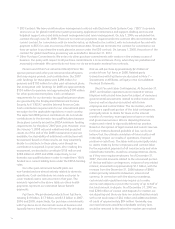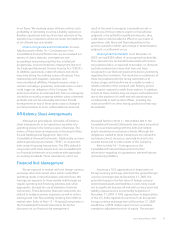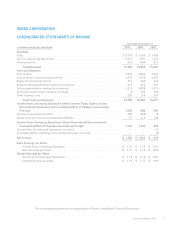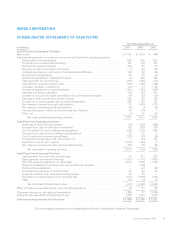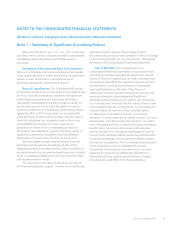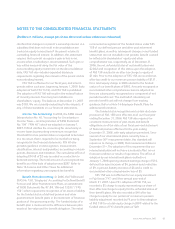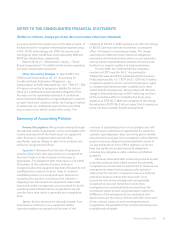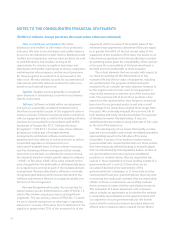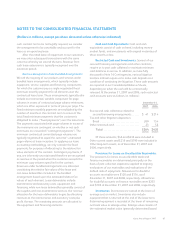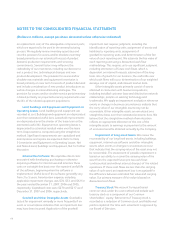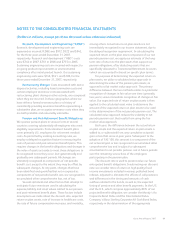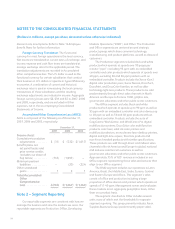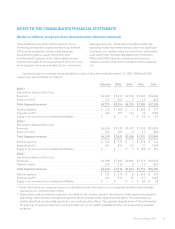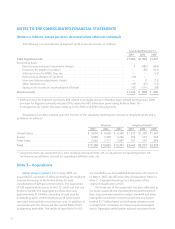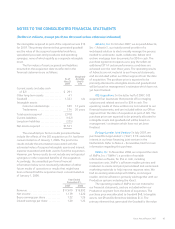Xerox 2007 Annual Report Download - page 85
Download and view the complete annual report
Please find page 85 of the 2007 Xerox annual report below. You can navigate through the pages in the report by either clicking on the pages listed below, or by using the keyword search tool below to find specific information within the annual report.NOTES TO THE CONSOLIDATED FINANCIAL STATEMENTS
(Dollars in millions, except per-share data and unless otherwise indicated)
clarifies that changes in a parent’s ownership interest in a
subsidiary that does not result in deconsolidation are
treated as equity transactions if the parent retains its
controlling financial interest. In addition, this statement
requires that a parent recognize a gain or loss in net
income when a subsidiary is deconsolidated. Such gain or
loss will be measured using the fair value of the
noncontrolling equity investment on the deconsolidation
date. FAS 160 also includes expanded disclosure
requirements regarding the interests of the parent and its
noncontrolling interest.
FAS 160 is effective for our fiscal year, and interim
periods within such year, beginning January 1, 2009. Early
adoption of both FAS 141(R) and FAS 160 is prohibited.
The adoption of FAS 160 will result in the reclassification
of minority interests from long term liabilities to
shareholders’ equity. The balance at December 31, 2007
was $103. We are currently evaluating further impacts, if
any, of these standards on our financial statements.
Income Tax Accounting: In 2006, the FASB issued
Interpretation No. 48, “Accounting for Uncertainty in
Income Taxes – an Interpretation of FASB Statement
No. 109” (“FIN 48”) which we adopted on January 1,
2007. FIN 48 clarifies the accounting for uncertainty in
income taxes by prescribing a minimum recognition
threshold for a tax position taken or expected to be taken
in a tax return that is required to be met before being
recognized in the financial statements. FIN 48 also
provides guidance on derecognition, measurement,
classification, interest and penalties, accounting in interim
periods, disclosure and transition. The cumulative effect of
adopting FIN 48 of $2 was recorded as a reduction to
Retained earnings. The total amount of unrecognized tax
benefits as of the date of adoption was $287. Refer to
Note 15-Income and Other Taxes for additional
information regarding unrecognized tax benefits.
Benefit Plans Accounting: In 2006, the FASB issued
SFAS No. 158, “Employers’ Accounting for Defined Benefit
Pension and Other Postretirement Plans, an amendment
of FASB Statements No. 87, 88, 106 and 132(R)” (“FAS
158”) which requires the recognition of an asset or liability
for the funded status of defined pension and other
postretirement benefit plans in the statement of financial
position of the sponsoring entity. The funded status of a
benefit plan is measured as the difference between plan
assets at fair value and the benefit obligation. The initial
incremental recognition of the funded status under FAS
158 of our defined pension and other post retirement
benefit plans, as well as subsequent changes in our funded
status that are not included in net periodic benefit cost will
be reflected in shareholders’ equity and other
comprehensive loss, respectively. As of December 31,
2006, the net unfunded status of our benefit plans was
$2,842 and recognition of this status upon the adoption
of FAS 158 resulted in an after-tax charge to equity of
$1,024. Prior to the adoption of FAS 158, we recorded an
after-tax credit to our minimum pension liability of $131,
for a total equity charge in 2006 related to the funded
status of our benefit plans of $893. Amounts recognized in
accumulated other comprehensive loss are adjusted as
they are subsequently recognized as a component of net
periodic benefit cost. The method of calculating net
periodic benefit cost will not change from existing
guidance. Refer to Note 14-Employee Benefit Plans for
additional information.
The funded status recognition and certain disclosure
provisions of FAS 158 were effective as of our fiscal year
ending December 31, 2006. FAS 158 also requires the
consistent measurement of plan assets and benefit
obligations as of the date of our fiscal year-end statement
of financial position effective for the year ending
December 31, 2008, with early adoption permitted. Since
several of our international plans currently have a
September 30th measurement date, this standard will
require us to change, in 2008, that measurement date to
December 31st. The adoption of this requirement by our
international plans will not have a material effect on our
financial condition or results of operations. The effect of
adoption by our international plans resulted in a
January 1, 2008 opening retained earnings charge of $16,
deferred tax asset increase of $4, pension asset reduction
of $9, a pension liability increase of $6 and a credit to
accumulated other comprehensive loss of $5.
FAS 158 was not effective for our equity investment
in Fuji Xerox (“FX”) until their annual year-end of
March 31, 2007. Upon FX’s adoption of FAS 158, we
recorded a $5 charge to equity representing our share of
their after-tax charge to equity for the unfunded status of
their benefit plans. We also recorded a $44 after-tax
charge to equity for our portion of a minimum pension
liability adjustment recorded by FX prior to their adoption
of FAS 158 for a total equity charge in 2007 related to the
funded status of FX’s benefit plans of $49.
Xerox Annual Report 2007 83



